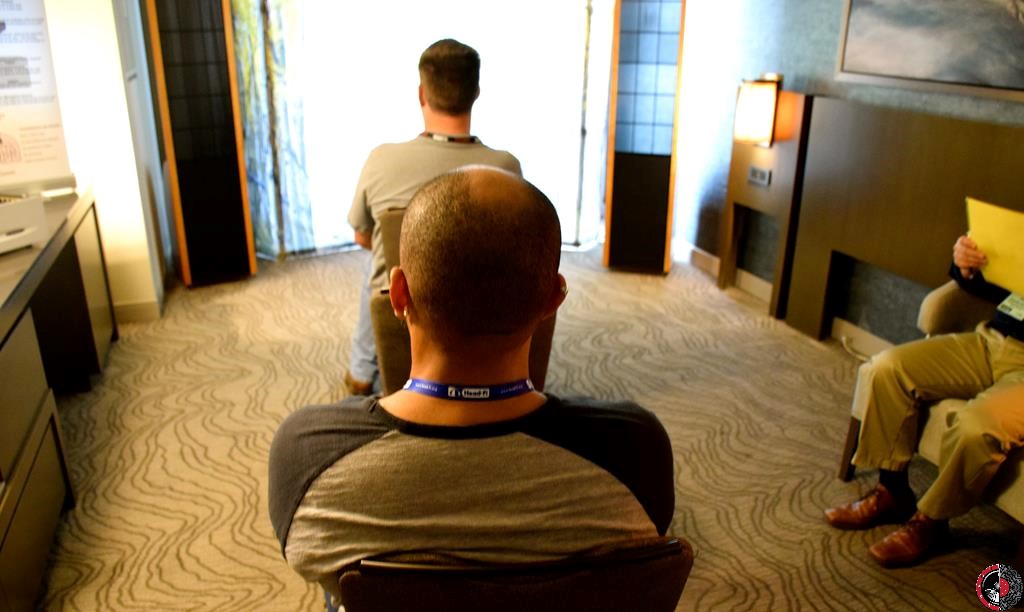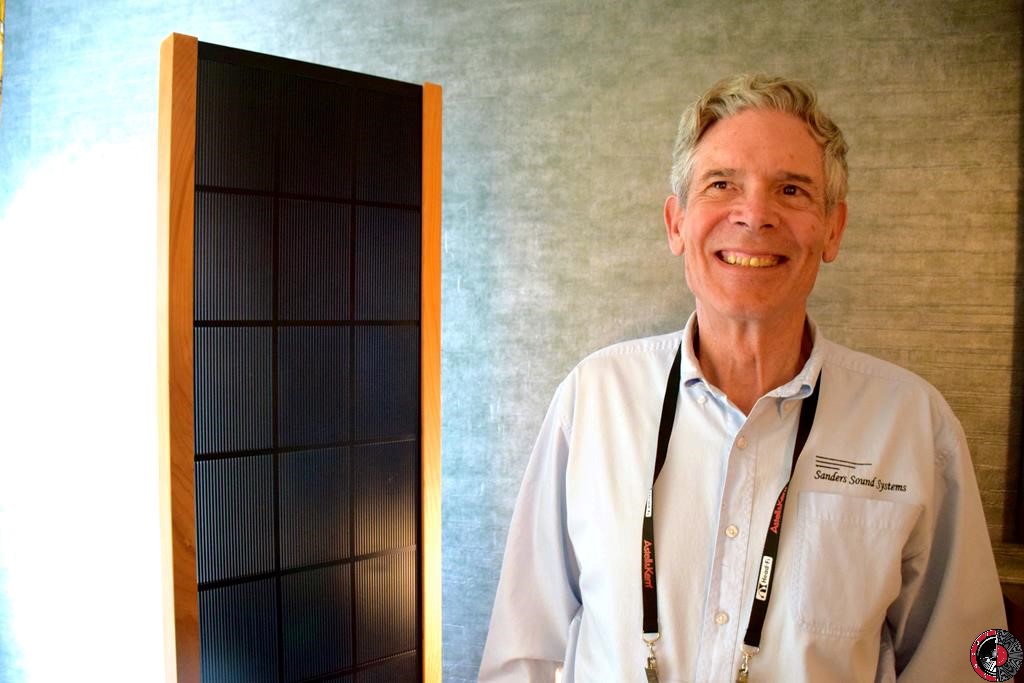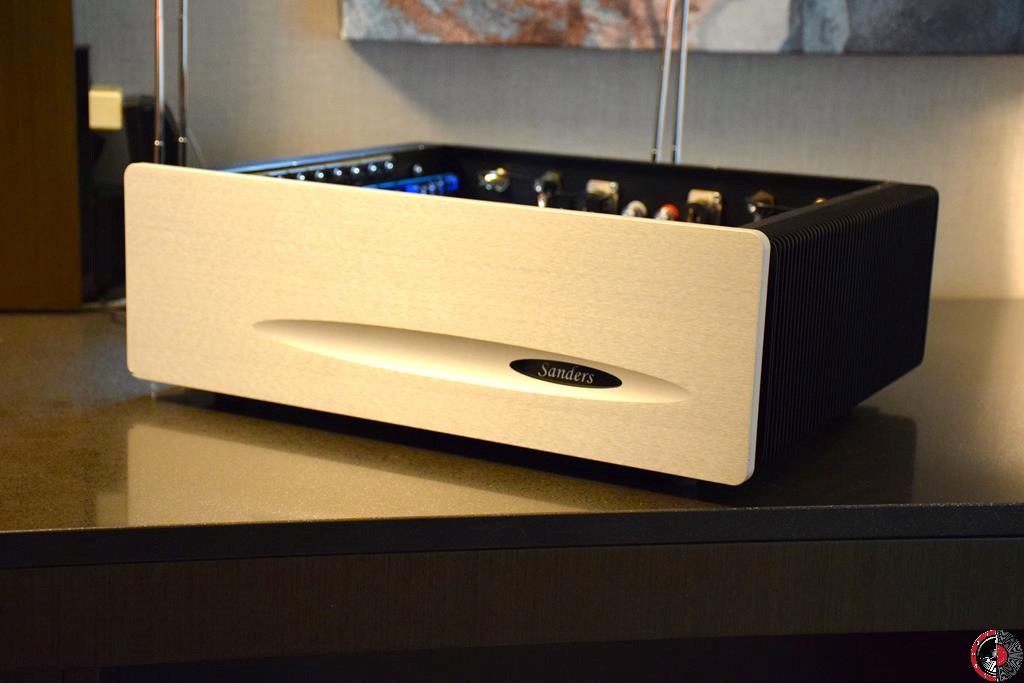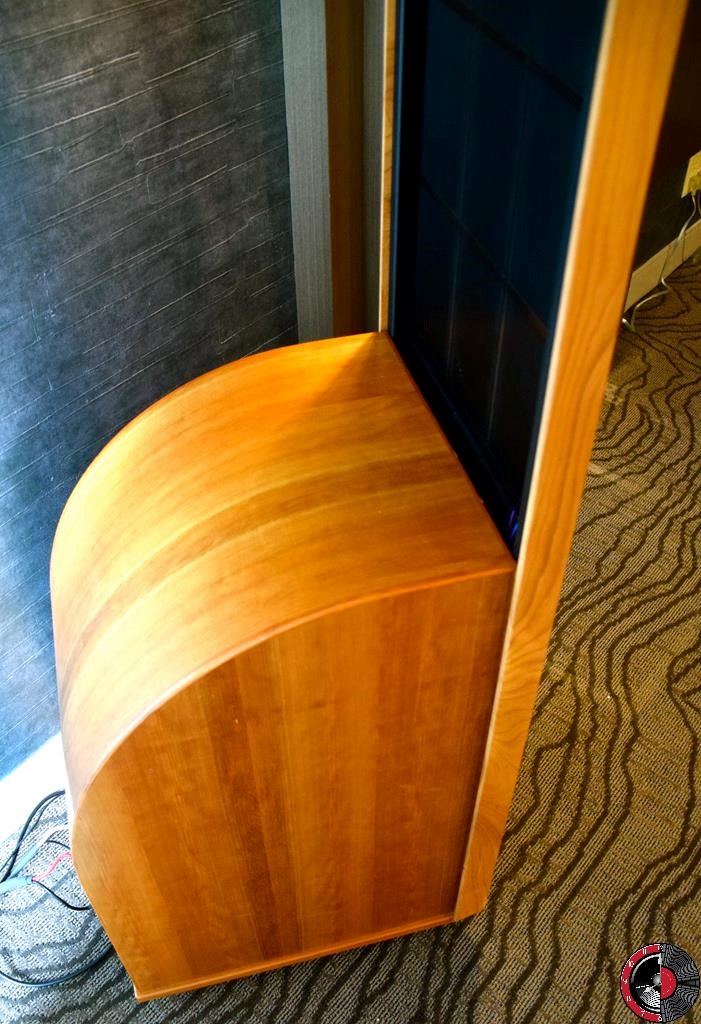
By John Stancavage
Roger Sanders doesn’t attend many audio shows these days. For an industry pioneer and company CEO, he’s remarkably low-key. But if you catch him in the right mood outside the door of his exhibit room and ask good questions, look out. He’ll talk your ears off.
That was the very pleasant — and fascinating — experience I enjoyed at the 2016 Rocky Mountain Audio Fest. I had just completed a lengthy demo of the Sanders Sound Systems Model 10e electrostatic hybrids with a company rep when I stepped out the door and ran into the founder holding court with another audiophile.
 I started out with a simple query (“How do you keep the cone-driven bass from intruding into the panels?”). And, before I knew it, 45 minutes had gone by. It seemed like a fraction of that time, though, as I got a primer on speaker-building and electrostatics from a man who — to paraphrase “Lethal Weapon” — may have forgotten more about those subjects than most engineers will ever know.
I started out with a simple query (“How do you keep the cone-driven bass from intruding into the panels?”). And, before I knew it, 45 minutes had gone by. It seemed like a fraction of that time, though, as I got a primer on speaker-building and electrostatics from a man who — to paraphrase “Lethal Weapon” — may have forgotten more about those subjects than most engineers will ever know.
The sound of the Model 10e was still reverberating in my ears. The demo had included a wide variety of musical genres, including jazz, pop and rock, along with the usual drum-and-percussion-heavy, audio-show tracks.
Willie Nelson’s “Stardust,” in particular, was stunning, with the spliff-loving legend’s weathered voice sounding more textured and authentic than I’ve ever heard it. Stevie Ray Vaughan’s “Tin Pan Alley,” meanwhile, proved this hybrid electrostat had no stereotypical politeness. Double Trouble was in the house, and you needn’t bother knockin.’
As part of the demo, the Sanders rep turned the panels off, using the proprietary digital line stage/electronic crossover. Immediately, vocalists and everything from the midrange up dropped out. I don’t mean those frequencies were somewhat attenuated or faded to a whisper — I mean they completely disappeared, leaving only the pulsing bass and steady kick drum.
With the test, it was easy to see why Sanders’ design enjoys such clarity. Combined with the strong, fast output from the aluminum woofer and the hybrid’s uncommon dynamic punch and high-power handing capability, Sanders seems to have found a way to make electrostats do things few — if any — others can.
“Electrostatic panels are like a stretched drum head. They ring at lower frequencies. So, I set my crossover at 170 Hz to avoid a resonance at 86 Hz. Then I use a sharp 48 decibel-per-octave filter to roll off the bass fast, before it gets into the midrange,” he told me.
If Sanders stopped there, he’d probably have a pretty fine speaker. But, with the Model 10e, he’s gone beyond — far, far beyond. His website is filled with the kind of long, detailed white papers you might find in an engineering journal. Sanders has thought this stuff out, and he’s not afraid to stand against convention.
RMAF coverage courtesy of Noble Audio: https://nobleaudio.com/
One of his iconoclast views concerns the sweet spot. Sanders sets up his demo rooms with a single line of chairs dead center on a line from the midpoint of the plane the speakers are in. That leads some to knock his choice of flat panels for his towers. But Sanders contends that curved panels (a concept he engineered himself, then abandoned) produce smearing and resonances. A flat panel is more accurate, he believes.
 “It’s all physics,” he said, as he got more animated during our chat. “Creating a wider sweet spot is a myth. Every speaker — and this includes cones — has one optimal listening position. With my speakers, you can move your head away from that spot and still hear good sound. But for the best imaging, with any speaker, you need to be in one place.”
“It’s all physics,” he said, as he got more animated during our chat. “Creating a wider sweet spot is a myth. Every speaker — and this includes cones — has one optimal listening position. With my speakers, you can move your head away from that spot and still hear good sound. But for the best imaging, with any speaker, you need to be in one place.”
His obsession with this issue and high-end sound in general has led him to study every imaginable factor that goes into producing state-of-the-art fidelity. And when you listen to him expound on his theories, they all seem to make perfect sense. Partly, this could be due to his enthusiasm, which hasn’t waned since he started his audio experiments decades ago.
Other keys to the 10e sound include careful time alignment and extremely low distortion. In addition, Sanders would like to control the electronics side as well.
Each Model 10e ($17,000 a pair) comes with its own house-made Magtech stereo amplifier and the aforementioned preamp/processor, which also offers digital room correction and DSD equalization. Those functions are said to be user-friendly.
Another amp also is needed, since the system must be bi-amplified. The buyer can used an existing amp or buy another Magtech for $5,500. In the case of the latter, that would push the overall cost up to $22,500.
Looked at as a whole system, and considering the reference-level reproduction and handsome woodwork, you could make a strong case that the 10e is one of high-end audio’s true bargains.
“I’ve been told by many people in the industry that I should charge more,” he said. “Some potential customers have been put off because they thought they should be spending more — that doing so would somehow get them better sound. But I just want to offer the best product I can at the most affordable price possible.”
Listening to Sanders, I got the impression he really is being earnest about this. If you peeked into his garage, I doubt you’d see a Lamborghini in there.
Meanwhile, he spends his time selling his speakers and electronics direct from his Colorado office/factory (there’s a 30-day risk-free trial) and not particularly courting publicity for himself or his company. But why do that, anyway, when your products speak for themselves?
Sanders Sound Systems
By Darryl Lindberg
I admit it: I’m an absolute sucker for electrostatic speakers. There’s just nothing like the presentation of a good electrostatic speaker in terms of speed, delicacy, transparency, and very low distortion. And the Sanders Sound System setup featuring their Model 10e ($17K, including the Sanders Magtech amplifier) sounded much better than merely “good;” in fact, it sounded excellent to my ears. The 10e features a 15”x42” electronic panel over a 10” aluminum transmission line-loaded woofer, adding up to an elegant 69” package that should suit a variety of rooms. Although the selections played while I was in the room were unfamiliar, there was no mistaking that ol’ electrostatic black magic: crystal clear and three dimensional as all get out.
 As you’re probably aware, there are two aspects of electrostatic speakers that require addressing: bass response and the beamy nature of panels with increasing frequency. The fact is that an electrostatic speakers’ bass response is usually limited unless the panel itself is of non-domestic bliss dimensions, so employing a cone or cones to do the heavy low frequency lifting is often the solution. However, it takes a well-engineered design to ensure that changeover between the panel and the woofer is as invisible as possible. And that was sure the case with the 10e, which delivered tight, well-controlled bass that went down to satisfying—if not seismic—regions.
As you’re probably aware, there are two aspects of electrostatic speakers that require addressing: bass response and the beamy nature of panels with increasing frequency. The fact is that an electrostatic speakers’ bass response is usually limited unless the panel itself is of non-domestic bliss dimensions, so employing a cone or cones to do the heavy low frequency lifting is often the solution. However, it takes a well-engineered design to ensure that changeover between the panel and the woofer is as invisible as possible. And that was sure the case with the 10e, which delivered tight, well-controlled bass that went down to satisfying—if not seismic—regions.
In terms of beaming, well . . . there’s not much you can do about it engineering-wise, so you’re going to have to accept a small sweet spot. But Sanders, to their credit, didn’t try to obscure this characteristic and set up the room to really optimize the listening position of the system: three chairs that formed what’s commonly referred to as the “audiophile choo-choo.” It may have ultimately limited the total number of listeners who passed through, but those who sat in one of the three chairs were sure treated to some excellent sound. Bravo!














I spent quite a bit of time in this room…it was outstanding!! I’ve been to many shows going back to the old Bay Area Stereophile shows of the late 80’s (L.A. as well). My experience in the Sanders room was the best of the show for myself. The man knows what he’s doing. The power & dynamics of these speakers were good for any speaker, outstanding for an electrostatic! The price, though certainly not “cheap”, seems reasonable for the amazing capability of these transducers (and amplifier for the base driver).
The sound in this room was exceptional — one of the best at RMAF.
I visited Roger a number of years ago and was just amazed at his absolute brilliance and conviction. Neither of which is limited to his ESL products or audio playback in general.
“In terms of beaming, well . . . there’s not much you can do about it engineering-wise, so you’re going to have to accept a small sweet spot.”
Obviously, he is ignoring Sound Lab electrostatics. They do it all, with a single driver, and like the court hall, you can sit anywhere you want.
I would argue that, even with the Sound Labs, there is an optimal sweet spot. The question, I think, is which sounds better when you are in that spot? Sound Labs do a pretty good job, but there are tradoffs to those curved panels, including timing and focus issues, smearing and soundstage problems. Those full-range panels, to my ears, can’t match the tightness, depth and accuracy of Sanders’ aluminum woofers. Play a Led Zepplin track on each and pick which one sounds like a real rock drum kit. Sanders also has found a way for ‘stats to play loud without compression, upper-frequency edginess or congestion. This is not to disparage any other manufacturer. I just think Sanders’ engineering ideas overcome a lot of the typical weaknesses of many panel speakers.
As a former–and long time owner (13 years)–of Sound-Lab A3s, I can confirm that the sweet spot was not as restricted as the Sanders panels. In addition, the continuity of its single driver gave these speakers a coherence that was breathtaking. However, I must respectfully disagree with your statement “you can sit anywhere you want” when listening to Sound-Labs. In my experience, the best listening position for the A3s was about where you’d expect it: the listening chair at the apex of the isosceles (or equilateral, depending on the room) triangle formed by the two speakers and the chair. The A3s certainly had a bit more horizontal and vertical “wiggle room” than the Sanders speakers, but not nearly as much as typical dynamic speakers. It should also be pointed out that most Sound-Lab speakers are considerably larger than the Sanders speakers, more expensive, and don’t include an amplifier. That said, there’s no denying the magic of a well-engineered electrostatic speaker, whether it’s from Sanders, Sound-Lab, or Quad.
Link is broken. This is one room I really wanted to hear about!
Paul D. Gilbert
Lockheed Martin
Transition / Integration Planner
719 567-4608